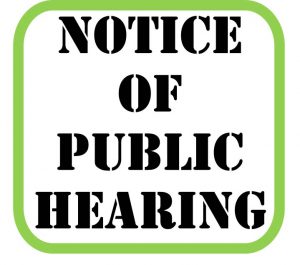Air Quality
2018: Worst Smog in Five Years…and Ozone Season Isn’t Over
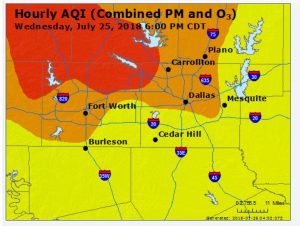
With months of “ozone season” still to come, 2018 is already one of the worst years of DFW smog pollution this decade.
As of August 9th, six out of the 20 North Texas ozone pollution monitors have registered at least four days when the average concentrations of smog were 80 parts per billion or higher over any eight-hour period. The current EPA ozone standard is 70 ppb over eight hours. Most scientists who study ozone pollution recommend between 60 and 65 ppb.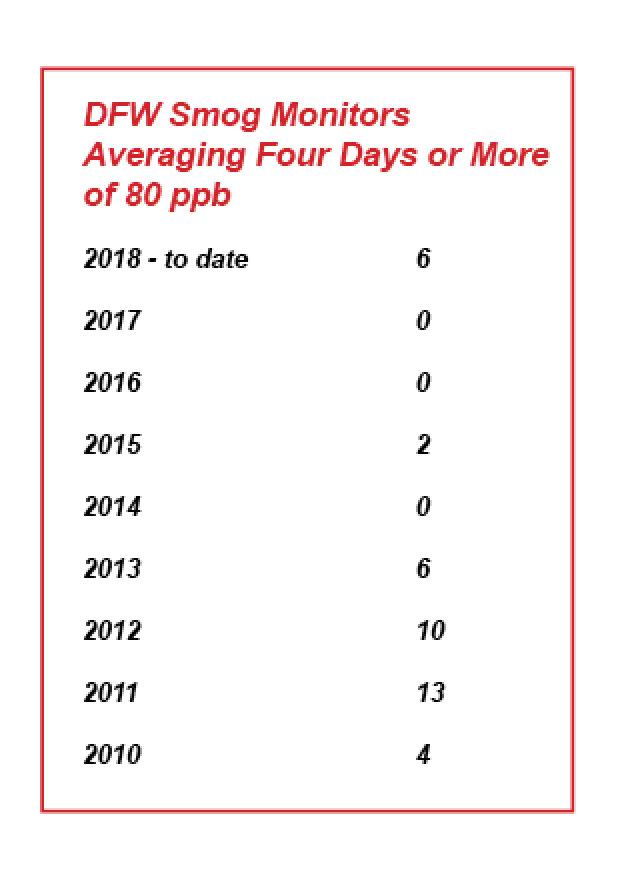
Unfortunately our lungs don’t breathe averages. Regulatory accounting smooths out the highs and lows. This summer has seen at least five sites record smog in the 90-95 ppb range for more than an hour. That’s very hazardous breathing.
There’s no question there were public health consequences to those extreme air pollution levels. Asthma attacks were triggered, COPD patients were gasping, but also strokes and heart attacks. We just don’t know how many…until after the fact.
It’s the first time in two years that any DFW monitors have had 8-hour averages of 80 ppb or above, and the first time since 2013 since there been at least six. In fact, this year’s total number of 80-or-above monitors is almost equal to the total number from the last five years combined.
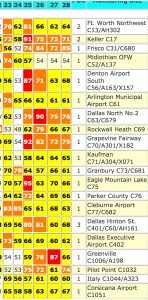
The last week of July was a bad one for DFW breathers.
Besides the number of high smog readings, the location of the monitors recording them should be of concern. Five out of the six registering the highest numbers this year have long histories of being among those registering the highest numbers in past years – Grapevine, Eagle Mountain Lake, Dallas Hinton, Dallas North and Frisco. Only Cleburne might be considered an outlier. The fact the same sites keep popping up over and over again means the strategies for reducing smog pollution aren’t working when put to the test like this July’s heat wave.
But of course that assumes there are any strategies for reducing smog in DFW. And technically there are. But they aren’t being vetted for their effectiveness, and they aren’t being enforced, and some are even being rolled back. After 27 years of continually violating the Clean Air Act for smog pollution, there’s nobody in any level of government working on a cogent plan to get DFW into compliance. Law and order rhetoric from Austin and Washington not withstanding.
What made July smog worse than usual was the heat. Climate scientists are telling us we’re going to be having more summers like 2018, not fewer. So this year’s levels are probably a precursor, not an aberration. But that’s a hard sell to elected officials whose campaign accounts depend on denying the science.
The punch line to this year’s sudden and dramatic spike in higher smog levels? It might still result in officials taking the Orwellian stand that the air in DFW is getting better. How is such a thing possible? Through the wonders of regulatory math.
EPA’s classification of how bad or good air quality is in any region is done by taking the 4th highest annual reading from each monitor and then keeping a rolling average of three years’ of those annual 4th highest numbers for each monitor. For this year, only the 4th highest numbers for 2016, 2017 and 2018 are included in the rolling average. Denton did see high numbers in 2015, but those are all now rolling off and not being counted.
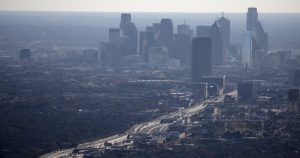
Up to now those 2015 numbers have kept the regional smog average in Denton at 81 ppb despite relatively light ozone seasons in 2016 and 2017. Now that that 2015 high number is rolling off, it would take the Denton site having 4 separate days of 90+ ppb smog in the next 90 days to make the average rise back up to 81 ppb. If that doesn’t occur, then the Denton average could drop to somewhere in the mid-to-upper 70 ppb range.
Should that happen, expect to see lots of regional back-slapping among officialdom for bringing down that Denton number and “continuing to make air quality progress.” Even as more monitor sites see higher smog numbers, officials will declare their anti-pollution measures are working splendidly. But that will not be the case, and you should not be misled.
While there might be a bit of specific progress made at the Denton monitor site, the increase in the number of other sites registering higher levels of smog they haven’t seen in years negates it. If all it takes is a heat wave to send two years of lower numbers down the drain, and the future is full of heat waves, then that’s not really progress, is it? We’re forced to put our fate in the hands of the weather instead of our own planning. Not very proactive, but that’s the state of air pollution control in DFW in 2018: “Please Dear God, keep it cool this summer.”
Even before the Trump Administration came into office the EPA wasn’t enforcing provisions of the Clean Air Act that DFW blew by ages ago – not correctly classifying its non-compliance, not requiring controls on major polluters, providing one extension after another. Now of course, there’s total abdication of even the pretense of striving toward cleaner air for its own sake.
Which is why if any progress is going to be made over the next 2-3 years, it must be made at the local level. No one else gives a damn. Officially.
THE CLEAN AIR FUND THAT TIME FORGOT
Over a decade ago $500,000 was collected from North Texas local governments to protect Texas air.
It’s been sitting in a bank account ever since. Until recently, not too many people even knew it existed.
Now, citizens want to use a part of it to build a world-class 21st-Century air monitoring network for DFW.
__________________________________________
In 2006, then-Dallas Mayor Laura Miller teamed up with Houston Mayor Bill White and organized a coalition of Texas local governments to oppose the “fast-track” permitting of a dozen new coal plants Governor Rick Perry was pushing.
15 North Texas cities, Houston, and McLennan County (Waco) established the “Texas Clean Air Cities Coalition” to fund a legal team and the technical expertise needed to take on not only the big utility companies, but Perry and the State of Texas as well.
But before the battles could begin, a settlement was reached that cancelled all but one of the coal plants. The approximately $500,000 raised by the Coalition to wage clean air war was not needed now. Instead of reimbursing the separate contributors, it was kept in total by the Coalition, possibly because it had already been budgeted to “protect Texas air.”
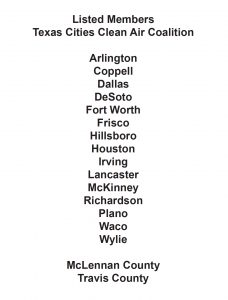
And there it’s sat ever since. With each new election cycle, the number of local elected officials who knew about the fund got smaller and smaller, until there was hardly any institutional memory of the Coalition or its half-million dollar fund left at all.
Downwinders only recently found about the money in the course of discussing funding of the new regional air quality monitoring network we’re working to establish with local policymakers.
While visiting with Dallas Council Member Scott Griggs about Dallas establishing such a network in partnership with Plano and Dallas County, CM Griggs mentioned the Texas Clean Air Cities Coalition and the $500,000 it had accrued, and asked us how our Network idea was different than the TCACC mission. We consider ourselves the premiere clean air watchdog group in DFW but we had no idea the Coalition or its fund was still around.
And, as it turns out, Griggs is the “Principal Officer” of the fund.
Needless to say, we were gobsmacked.
After reviewing some paperwork on the Coalition in Griggs’ office, we answered his question by suggesting that while the original goal of TCACC was to actively oppose those “fast-tracked” coal plant permits, the mission of the monitor network was to gather air quality information for public health purposes.
But on closer examination, we did notice similarities. Many of the municipalities that contributed to the Coalition fund are the same ones that are now interested in participating in the new monitor network, which like the Coalition, is a regional effort. The Mission of the Coalition is “to protect Texas air” primarily, but not exclusively through permit opposition. The spirit, if not the mechanics of the Coalition and Network are originating out of the same concern for public health.
That being said, extracting the money from the fund for modern use could be a convoluted affair. Despite the broad executive 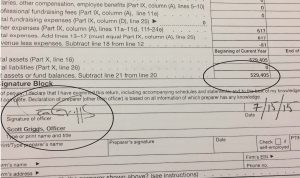 powers given to the Principal Officer in the Coalition’s by-laws, including the authority to commence litigation and intervene in permit proceedings, they don’t address air quality monitoring directly per se. It would appear to take a vote of the remaining Coalition members to ratify a new expenditure for the regional monitoring network, but it’s not clear who they are.
powers given to the Principal Officer in the Coalition’s by-laws, including the authority to commence litigation and intervene in permit proceedings, they don’t address air quality monitoring directly per se. It would appear to take a vote of the remaining Coalition members to ratify a new expenditure for the regional monitoring network, but it’s not clear who they are.
Of the five Coalition officer positions listed in the paperwork Downwinders received from Griggs, three would appear to be vacant, with no one representing Houston, Waco, or Irving due to retirements or elections. Only Griggs and Arlington City Council member Kathryn Wilemon, who both term out in May 2019, remain in elected office.
The discovery of the Coalition fund in 2018 raises all sorts of questions about why it didn’t get used over the last decade of air quality problems. Although there hasn’t been another tsunami of coal plants proposed, there’s still cement plant plants burning industrial waste, still oil and gas facilities still releasing way too much methane, still battles over batch plants in places like West Dallas and Joppa that the money could have gone to…but didn’t. Advocates like Downwinders didn’t even know about it to be able to make the case for its use. It’s a large policy failure on all fronts, that perhaps can be partially redeemed now by spending some of the the collected monies on another regional clean air initiative.
After learning of the Coalition fund, Downwinders asked Dr. David Lary of the University of Texas at Dallas Engineering Department to outline what kind of North Texas air monitoring network could be built with approximately HALF of the fund’s $530,000.
Dr. Lary is the author of the National Science Foundation grant that originally proposed the idea of grid air monitoring in DFW. He’s an expert in the field of high-tech low cost sensors and just got a large US Army contract for testing sensor equipment for the nation’s armed forces.
What he suggested was a 200 + sensor network, operating mostly on solar power and using wifi to bring real time air quality information to the regions seven million residents..for a low, low price of $280,000. This is his itemization:
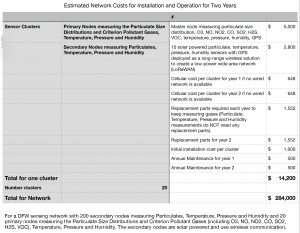
All previous plans had any regional monitoring network growing slowly by charging affordable fees for purchase and installation of sensors. If there’s a large clean air fund that could pay for the immediate build-out, it would propel DFW into the front ranks of “smart cities” and provide public health benefits much sooner.
Now that a City Council Quality of Life Committee hearing has been set for Dallas to decide whether to join the monitor network, the opportunities the fund could provide deserve overdue attention. The question of what role the fund can or should play in paying for a new regional clean air network will be important. Having squandered the ability to provide the kind of assistance it was created for over a decade ago, let’s hope current officials don’t make the same mistake and ignore public health…again.
Dallas City Council Committee Sets August 27th Hearing on Joining New Regional Air Quality Monitoring Network
WE NEED YOU
TO SPEAK OUT….
FOR CLEAN AIR!….
FOR PUBLIC HEALTH!….
FOR ENVIRONMENTAL JUSTICE!…..
FOR SCIENCE!
MONDAY, AUGUST 27th
9 AM
ROOM 6 ES
DALLAS CITY HALL
1500 MARILLA
DALLAS CITY COUNCIL
QUALITY OF LIFE COMMITTEE
PUBLIC HEARING:
Should Dallas join Dallas County and Plano in establishing a new regional air quality monitoring network
Share the FaceBook Event Page 
Dallas residents’ Right-to-Know what’s in the air they’re breathing could take a big step on Monday, August 27th.
That’s when the Dallas City Council’s Quality of Life Committee will hold a public hearing to decide if the City should join a new regional air quality monitoring network. It’s the most important decision concerning Dallas city-wide air quality in years.
Why? Because information is power.
Despite the fact you breath lots more air than you eat food or drink water, product labeling allows you to know more about what you’re putting in your stomach than what you’re putting in your lungs. A 21st-Century air monitoring network would begin to correct that imbalance.
Unlike the current handful of monitors operated by the Texas Commission on Environmental Quality (TCEQ) and EPA, this new local network would have hundreds of small high-tech, low-cost sensors and they’d be reporting their information in real time on a phone-accessible app.
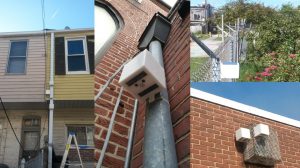 Despite being the home to 2.5 million people, and covering an area slightly smaller than the state of Rhode Island, Dallas County has only a single official monitor for deadly Particulate Matter pollution you can access online. Unless you live within close proximity of that one monitor you don’t have much idea of what kind of crap you’re inhaling.
Despite being the home to 2.5 million people, and covering an area slightly smaller than the state of Rhode Island, Dallas County has only a single official monitor for deadly Particulate Matter pollution you can access online. Unless you live within close proximity of that one monitor you don’t have much idea of what kind of crap you’re inhaling.
Being able to access real time air quality information no matter where you in DFW are has the potential to transform personal habits and public policy.
Residents with asthma or other breathing problems will have a much better picture of the air they’re actually being exposed to, down to the specific neighborhood or even street block. They can pro-actively plot a path to avoid polluted parts of town, or wait to take that walk or run.
Hotspots of pollution will be more readily identified by the people most affected by them. And, if we organize, that means they’ll get more notice from policymakers too.
Public health officials will be able to track school absentee rates with “bad air days.” City traffic engineers can time stoplights to reduce vehicle pollution. We’ll know which neighborhoods already experience a lot of air pollution and shouldn’t be candidates for siting new industrial facilities.
This is why the Dallas City Hall IT staff not only included high tech air quality monitoring in the category of “Public Health and Safety” but also “Equity and Empowerment.” This network and the information it provides can be a powerful tool for citizens.
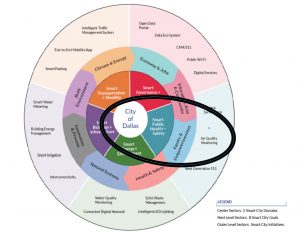
There are many ramifications to having this information available – some obvious, some we can’t imagine yet. High-tech air quality monitoring is one of the most useful applications of emerging “smart cities” technology.
Chicago is installing a grid of over 500 air quality sensors. Baltimore is doing the same. LA is committed to at least 100. Even Chattanooga, Tennessee has its own network. Now DFW, home to some of the worst air in the country for decades, has a chance to do the same.
Dallas’ Quality of Life Committee is Chaired by three-term council veteran Sandy Greyson, and includes rumored Mayoral candidate Scott Griggs, Mark Clayton, Omar Narvaez, Jennifer Staubach-Gates, Adam McGough, and Ricky Callahan.
If the Committee votes to join the Network, it’s recommendations would then be forwarded to the the entire 15-member City Council for formal approval.
As proposed, The North Texas Clean Air Network would be administered by a board that includes public health experts from Parkland and the Dallas County Medical Society, officials from every city, county, hospital or school district that become members and public interest advocates. This board would decide where to put new monitors, insure their technical proficiency, and help educate the public about the network.
Officially, it’s chartered goals are to
1. Provide the best, most up-to-date factual information about local air quality by supervising the implementation and maintenance of a publicly accessible, secure, and scientifically credible regional air sensor network providing simultaneous real time air quality information from multiple locations within member or contracted jurisdictions via the World Wide Web.
2. Provide fact-based public education resources on local air quality.
3. Support scientific research on local air quality by local colleges, universities, hospitals and schools.
4. Work with regulatory agencies and entities to further local clean air goals.
The Network began as a National Science Foundation grant proposal led by Dr. David Lary of UTD. It requested funding for dense concentrations of monitors in Plano and Southeast Fort Worth. It got a rare call back by the NSF, but no money.
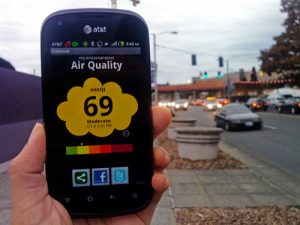 Still committed to the idea, the NSF grant partners then began building the same kind of monitor network across DFW using donations of resources and labor.
Still committed to the idea, the NSF grant partners then began building the same kind of monitor network across DFW using donations of resources and labor.
Over the past year, 30 Particulate Matter monitors have been bought or donated for this purpose. They’re being installed at community colleges, public schools, and one is being located in the Joppa neighborhood of Dallas. Consortium members now want to turn these monitors over to the proposed Network board so the system can be operated in the public interest as a kind of public utility.
There are no additional costs for the first wave of 30 monitors other than internet connectivity and minimal maintenance. More monitors can be added to the network by collecting fees for installation and using a portion for maintenance.
But as of last month, there’s an exciting new source of funding for the Network – an untapped regional clean air fund that over a dozen North Texas cities contributed to a decade ago and has sat unused ever since. Over $500,000 in local money has already been raised and budgeted to “protect Texas air.”
UTD’s Dr. Lary has proposed using slightly more than half of that collected money to build a sophisticated 200-sensor air quality network spanning across DFW measuring Particulate Matter pollution, temperature, pressure and humidity with an additional 20 primary monitors measuring the Particulate Size Distributions and Criterion Pollutant Gases (including O3, NO, NO2, CO, SO2,H2S, VOC), Temperature, Pressure and Humidity. The smaller 200 monitors are all solar-powered and use wifi.

Dallas has a reputation for desperately wanting to be known as “world-class” and a recent Morning News article noted how Dallas had a “high-tech image problem” among innovators. A 200-monitor high-tech air quality network would instantly propel the city into the ranks of the “smartest” wired metro areas in the US, not to mention advance the cause of local public health. Dallas could be ahead of the curve instead of behind it.
2018 is the 27th straight year Dallas and all of DFW will be in violation of the Clean Air Act. The State of Texas and the EPA have shown themselves to be unwilling to take the problem of dirty air seriously. Now its local government’s turn.
SHOW-UP ON MONDAY AUGUST 27th AT DALLAS CITY HALL AND SPEAK OUT FOR A PRO-ACTIVE RESPONSE TO DFW AIR POLLUTION PROBLEMS.
Historic: Texas’ First Citizens’ Smog Monitor Begins Operation in Wise County
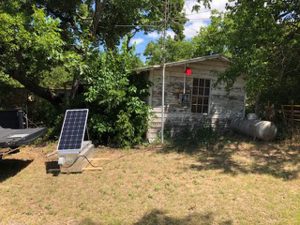
After a few technological hiccups, the state’s first permanent smog monitor built and operated by a citizens’ group is up and running in rural Southeast Wise County. And by the looks of this summer’s ozone season, just in the nick of time.

Conceived, designed, and supervised entirely by environmental scientist and UNT doctoral candidate Kari Northeim on behalf of Downwinders, the Atlas Monitoring Station is a first-of-its-kind adaptation of smaller, less expensive technology to perform the job of monitors many times its size and cost. It instantly becomes a huge milestone in our efforts to build a better system of air quality monitoring in North Texas.
The Atlas Station is a product of Downwinders’ Wise County Ozone Project, financed by a grant from Patagonia and an EarthTank prize won by Downwinders at EarthDay Texas in 2016. It’s objective is to collect continuous readings of Ozone, otherwise known as smog, in Wise County – until this week the only one of ten DFW “non-attainment” counties with no ozone monitors.
 Besides being downwind of much of DFW’s smog, Wise County is the birthplace of modern “fracking” and blistered with gas patch facilities that produce significant amounts of smog-causing air pollution. However, the nearest official smog monitors are approximately 30 miles to the east in Denton County and 20 miles south in Tarrant County. Despite past state and private computer modeling predicting smog to be worse in Wise County than the rest of North Texas when “ozone season” winds are out of the south-southeast, there’s been no monitor there to test that hypothesis. Until now.
Besides being downwind of much of DFW’s smog, Wise County is the birthplace of modern “fracking” and blistered with gas patch facilities that produce significant amounts of smog-causing air pollution. However, the nearest official smog monitors are approximately 30 miles to the east in Denton County and 20 miles south in Tarrant County. Despite past state and private computer modeling predicting smog to be worse in Wise County than the rest of North Texas when “ozone season” winds are out of the south-southeast, there’s been no monitor there to test that hypothesis. Until now. 
Accurate regional ozone readings are important to DFW because they determine how much in or out of compliance with the Clean Air Act we are. If smog levels being recorded by EPA monitors in their current locations aren’t reflective of higher smog levels actually being breathed in North Texas, then we need to know that and add more protective air pollution measures.
Last spring Downwinders bought two portable smog monitors the size of cable boxes from Colorado’s 2B Technologies at $5000 each. That’s a huge drop in price and size. Traditional EPA monitors doing the same job can cost hundreds of thousands of dollars and take up a quarter acre.
 2B factory-calibrates the monitors and they’re already certified by EPA, but from from June 2017 to March 2018, they were subject to additional testing by Kari at the University of North Texas (UNT) Engineering Lab.
2B factory-calibrates the monitors and they’re already certified by EPA, but from from June 2017 to March 2018, they were subject to additional testing by Kari at the University of North Texas (UNT) Engineering Lab.
Although small, these are incredibly reliable machines with an accuracy of greater than 1.5 parts per billion by volume, or 2% of the total reading. They measure ozone every ten seconds and can automatically average over a minute, 10 minute, or hour interval (like the state monitors do so we can compare apples to apples).
Small, portable, cheaper, but the monitors still need electricity. In order to have more siting options in a mostly rural county, the Atlas uses a 100 W solar panel to connect the monitors to the juice they need to take readings. Batteries provide back-up. This makes is a completely stand alone, self-sufficient monitoring station that we can put anywhere with a good south view.
Air is collected through a funnel and shuttled down a pipe that brings it into a weather-protected box where the monitor itself sits. 
During the Wise County Ozone Project, one monitor at a time will be deployed for a period of 3-6 months. Unfortunately, there’s not a way yet to get real time access to the monitor via the internet, so instead data will be downloaded by Kari every month and compared to readings at those Denton and Tarrant County monitors. Not perfect, but better than no monitor at all.
According to Northeim, who expects to be able to mine several scientific papers with the data she collects, “This research is critically important to develop an understanding of the true ozone exposure in Wise County. It’s very exciting.”
____________________________________________
Putting a Smog Monitor
Where No Smog Monitor Has Gone Before
EPA has 20 ozone, or smog, monitors in North Texas. Approximately half of those are considered “background” monitors on the edge of the denser urban areas. Originally the DFW “non-attainment area” for smog was only Dallas and Tarrant Counties. As the area’s populations grew, so did its air pollution problem and Denton, and Collin Counties were added, then Johnson, Parker, Rockwall, and Kaufman. Citizens petitioned and sued to bring Ellis And Wise Counties into the fold. All of these counties except Wise have an EPA smog monitor, despite Wise County being included in the non-attainment area since 2012, and despite state and private computer air modeling showing the County could have some of the region’s worst smog.
It’s Only June But DFW Is Already in Violation of the National Smog Standard
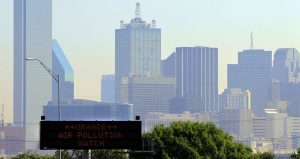 The early start to 100° + days in DFW this spring has meant an early start to high smog levels as well.
The early start to 100° + days in DFW this spring has meant an early start to high smog levels as well.
Although it’s not even summer yet, five official EPA ozone monitoring sites in North Texas have already recorded “4th highest” 8-hour ozone averages that put DFW above the 70 parts per billion federal standard for 2018: Grapevine 73 ppb, Keller 72 ppb, Dallas North (by I-635) 73 ppb, Dallas Hinton (Stemmons Freeway and Mockingbird) 72 ppb, and Denton Airport 72 ppb.
No matter what happens the rest of this 2018 “Ozone Season,” these numbers insure DFW will still be violating the Clean Air Act for a 27th year in a row.
Grapevine and Eagle Mountain Lake monitors have recorded the single highest 8-hour ozone levels in the state so far, at 89 and 92 ppb respectively.
Breathers will have to wait longer to find out how this year’s dosage will affect the all-important regional average, driven recently by the results from the Denton Airport monitor. The regional average is the highest 8-hour average number from any one monitor after averaging the 4th-highest ozone readings from each of the last three years. Extremely high years can be off-set by better years, or visa versa.
Slowly, the DFW regional ozone average has come down from the really bad old days of the 1990’s and early-Oughts. But for the last seven or so years, it’s plateaued in the 80-85 ppb range. As of 2017, Denton had a three-year, regional-leading average of 81 ppb.
Many observers believe the recent stagnation in the decrease of DFW smog is due to increased emissions generated by the Barnett Shale gas play taking up the slack from decreases from other large sources like kilns or cars.
A 2015 UNT study using the State’s own air modeling demonstrated the disproportional impact gas industry sources like compressors had on the area’s historically worst performing monitors in Northwest Tarrant County and Denton, accounting for up to 3 ppb of smog.
Closure or mothballing of three large East Texas coal plants will help keep the numbers down this summer from what they could have been, but it may not be enough to outweigh the impact of continued growth and reluctance by authorities to crack down on other large sources like the gas industry or the Midlothian cement plants.
And this summer’s early smog crisis is yet another reminder about why a 21st Century locally-controlled monitoring system is needed. During this last stretch of 100° + heat, when ozone levels were often climbing by 10 ppb or more per hour, the official EPA/State monitors were up to 2 and a half hours late. At 1 pm, a resident was still looking at 10 am data that was obsolete.
If the federal and state governments won’t do anything but make it more difficult to solve our chronic smog problem, it’s self-defense for local governments to at least be able to warn residents about how bad the air is in real time and at a location near them instead of the other side of town.
THIS COMING TUESDAY, MAY 22 YOU HAVE A CHANCE TO SUPPORT LOT OF GOOD CAUSES…ALL AT ONCE

The Top Five Reasons
You Should Attend the May 22nd Benefit for Joppa
1) This benefit will fund a citizen-run air quality monitoring network in Joppa that can be up and running in months.
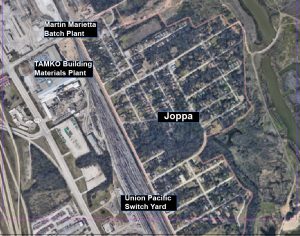 We don’t need the EPA to do anything to win a big environmental victory right now. Or the State. Or even the City of Dallas. Citizens can do this ourselves.
We don’t need the EPA to do anything to win a big environmental victory right now. Or the State. Or even the City of Dallas. Citizens can do this ourselves.
All the air monitoring technology we need is off the shelf. Thanks to the labs at local universities like UTD and UNT we have the expertise we need in our own backyard. All we need is the funding. Your $25 ticket fills that need. All proceeds go directly to buying monitors for Joppa.

2) This benefit supports an historic Black-Green alliance forming in Dallas
This benefit will see the debut of a new grassroots proposal to make Joppa a model of how municipalities can redressdecades of environmental racism. Over the last several months Joppa residents and environmental groups have worked closely together to prevent another two batch plants from setting-up shop. Now we’re ready to announce how we’ll be more pro-active. Come support this important and historic initiative.
3) This benefit supports an unprecedented pilot project that could be coming to a pair of lungs near you
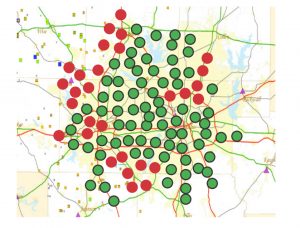 The Joppa community could be a launching pad for the much larger regional air monitoring network public health advocates and environmentalists want to establish. It’ll provide reliable real-time air quality readings from monitors located near you instead of many miles away. Joppa makes sense as the place to start because it won’t take a huge budget to cover the well-defined neighborhood with a dense grid of monitors. Joppa can help pave the way for a regional network.
The Joppa community could be a launching pad for the much larger regional air monitoring network public health advocates and environmentalists want to establish. It’ll provide reliable real-time air quality readings from monitors located near you instead of many miles away. Joppa makes sense as the place to start because it won’t take a huge budget to cover the well-defined neighborhood with a dense grid of monitors. Joppa can help pave the way for a regional network.
4) This benefit challenges Old Dallas
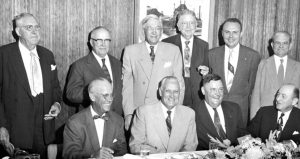
The Joppa Freedman’s Township Association (JFTA) was the only Joppa-based neighborhood group leading the fight against the two recently-proposed batch plants. They represent a more volunteer-oriented, grassroots approach to community organizing. They’re seen as a direct challenge to the Status Quo. Your presence at this benefit is a direct rebuke to the Old Dallas way of doing business. Come support a New South Dallas.
5) It’s going to be a great show with good food and good folks…for only $25
We’ve got a drum line. We’ve got one of the most talented local poets on the scene as MC. We have Civil Rights icon Peter Johnson giving a commencement address on why “Clean Air IS a Civil Right. We have selected scenes from Soul Rep Theater’s “The Freedmens” fresh off its run at the Wylie Theater downtown. We have the pipes of Vicki Larkin Tovar and the completely cool vibes of Solako Music. This is in addition to food and drink. All for only $25.
Tickets are Only $25. Tables of 10 only $250.
Don’t Miss This Historic Event.
GET YOUR TICKETS HERE


Join us on May 22 at our new digs in GoodWork Co-Working Space,
1808 S. Good-Latimer Expressway, just a few blocks south of I-30 and downtown Dallas….
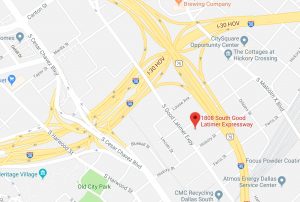

__________________________________________________________________________
For Immediate Release:
9 am May 15th, 2018
New Dallas Black-Green Alliance Hosts Benefit
to Bring Full Time Air Quality Monitoring to Joppa
May 22 event launches unprecedented new effort dedicated to
“undoing” decades of environmental racism in Dallas
(Dallas) Fresh from their victory over two proposed batch plants in late March, Joppa residents and Dallas environmentalists are joining forces again to host a benefit on May 22nd aimed at purchasing dedicated high-tech air monitors for the neighborhood. They say it’s a first step in a long-term commitment to lessen the pollution burden of “the best preserved” Freedmen town remaining in Dallas.
Offering a line-up that ties the historical neighborhood to the modern air pollution problems it faces, the Joppa Freedman’s Township Association and Downwinders at Risk are hosting “Let Joppa Breathe!”
from 7 to 9 pm next Tuesday, May 22. The Sticks Mania drum line will call the evening to order. Actors from the Soul Rep Theater will perform scenes from their recently concluded run of “The Freedmens” at the Wylie Theater. Civil Right veteran Peter Johnson will speak to “Why Clean Air IS a Civil Right.” Award-winning spoken word artist and poet Rage Almighty will be performing and is also Master Of Ceremonies. Local singers Selako Music and Vicki Larkin Tovar round out the evening’s entertainment. Dallas Council Member Kevin Felder, who led the fight opposing the batch plants at City Hall in March, will provide a welcome. Food by FOODWORK and Doodle Farm plus drinks are included in the $25 admission price. Tickets are being sold through EventBrite online. All proceeds go directly to buying air monitoring equipment that can be up and running in Joppa in a matter of months.
Plugging the community into on-going local air quality efforts means Joppa could have one of ten sophisticated Ozone and Particulate Matter (PM) monitors being built and distributed by the University of Texas at Dallas to locations throughout DFW by the end of summer as part of DFW’s first independent air quality information network. It will also be first in line to host five to ten additional, smaller PM monitors in the first “monitor grid” network of its kind in Texas. Dallas County currently has just one permanent EPA PM monitor, on Hinton Street near Stemmons Freeway, some nine miles from the Joppa neighborhood. Portable monitors owned by Downwinders found PM levels 30-50% higher in Joppa than at that EPA site on the weekend before the batch plant vote.
Building a new network of air monitors would seem ambitious enough, but according to the JFTA and Downwinders, that effort is only the first step in a campaign to make Joppa a model of how to undo decades of environmental racism. They’ll use the May 22nd benefit to unveil a proposal for a Joppa Environmental Protection District aimed at preventing the community from being a dumping ground for undesirable industry and improving its quality of life. Among its goals are electrification of all Union Pacific locomotives operating in the switchyard that runs the length of Joppa, HEPA air filters for all homes, new pollution controls for local industry, and zoning ordinances that establish special protections for historically abused communities like Joppa. It would be a first-of-its-kind District in Dallas whose architects are a first-of-its-kind alliance of Black South Dallas and local environmentalists.
“Everyone is tired of only re-acting to Bad Ideas. We want to stop the Bad Ideas before they ever get a Planning Commission hearing,” said Downwinders Director Jim Schermbeck. “That means the city admitting it has an environmental racism problem and working with residents to create new public public policy to correct it.”
Schermbeck noted that every “comprehensive plan” now moving through Dallas City Hall is impacted by environmental health and environmental racism – whether they’re acknowledged or not. “You can create a housing policy that ignores those realities, but at the end of the day people don’t want to live where they can’t breathe. You can pass an economic development plan, but unless you know where industry is causing problems now you may be adding to them rather then solving them. Environmental Health has traditionally been a stepchild issue at Dallas City Hall. That tradition must end if the City wants to accomplish its new goals.”
Organizers say that donations of equipment and volunteer time means they only need about $3-5,000 to set-up the kind of advanced air quality monitoring network that would be the envy of even the smartest of “smart cities.” They’ve already collected $1600 and hope the May 22 benefit brings in the remainder. “For $25, you can make sure we win an important environmental justice victory by the end of summer and have one heck of a good time.” said Schermbeck.
Tickets are Only $25. Tables of 10 only $250.
Don’t Miss This Historic Event.
GET YOUR TICKETS HERE
You’re Invited to an Evening of Celebration and Determination
Click Here for Tickets and Sponsorship
Joppa is one of Dallas’ most intact Freedman’s Township. One of only three left. It was founded by slaves liberated from the near-by Miller plantation on the banks of the Trinity River. Descendants of those slaves still own homes in Joppa.
But over the last century it’s been surrounded by heavy industry and tons of air 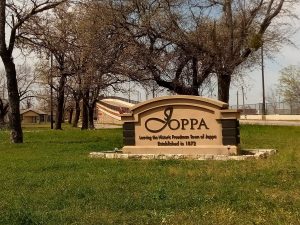 pollution. EPA’s nearest air monitor is nine miles away.
pollution. EPA’s nearest air monitor is nine miles away.
In March, the Joppa Freedman’s Township Association defeated a proposal to locate two additional concrete batch plants there when it came before the Dallas City Council. A week before the vote Downwinders at Risk board members used their new portable particulate matter monitors to show how high current high pollution levels already are.
Despite the community’s longtime pollution burden, it was the first time any actual air monitoring in the had actually been done there.
Now, the JFTA and Downwinders have agreed to partner in an unprecedented and historic way to try to redress decades of environmental racism by working for the creation of a”Joppa Environmental Preservation District.”
This new district would have special zoning and land use policies dedicated to reducing the amount of pollution Joppa residents are subjected to on a daily basis – all designed to “Let Joppa Breathe.”
 As a first step, we want this Environmental Preservation District to have more extensive air quality monitoring, especially for Particulate Matter.
As a first step, we want this Environmental Preservation District to have more extensive air quality monitoring, especially for Particulate Matter.
And to do that by this summer, we need your support on May 22nd.
That evening JFTA and Downwinders are hosting a benefit to raise money to buy multiple air quality monitors for the community.
Thanks to your generosity and the Dallas Sierra Club, we already have enough for one, but we need more – at least one on each side of the community and more if we can get them.
We want Joppa to be an example of the kind of dense monitoring we want to bring to all of DFW in the years ahead.
A $25 ticket gets you food, wine or beer, and a program highlighting the cultural and historical significance of Joppa as well as celebrating our determined effort to preserve and revitalize it.
Not only will we be unveiling more details about our plans on May 22, you’ll also be treated to a line-up of great entertainment, beginning with MC duties being performed by Dallas spoken word artist and poet Rage Almighty.
Come out on May 22nd to support a good cause, eat good food, and watch an inspiring program that will leave you fired-up and ready to go.
Click Here for Tickets and Sponsorship
THANKS TO YOUR GENEROSITY JOPPA FUNDRAISING IS A SUCCESS
Thanks to Downwinders supporters and the Dallas Sierra Club that pitched in a whopping $1000,  we raised the $1600 needed to buy Joppa residents their own full time Aeroqual Particulate Matter monitor. Now comes the hard part in deciding where to put it.
we raised the $1600 needed to buy Joppa residents their own full time Aeroqual Particulate Matter monitor. Now comes the hard part in deciding where to put it.
Downwinders and Joppa residents are schedule to meet to discuss the location of the monitor and the protocol surrounding the data gathering.
Unlike the monitors being proposed as the backbone of the new regional network, the Aeroqual model doesn’t connect to the Internet as it collects its data in real time. It’s readings have to be downloaded and examined offline.
There’s also the issue of whether to leave the monitor in one place or move it around the 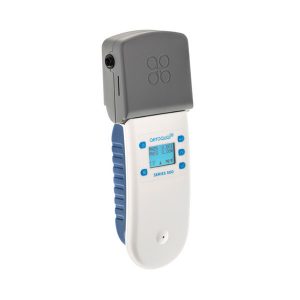 neighborhood to test where those new internet-connected network monitors might go when they get here.
neighborhood to test where those new internet-connected network monitors might go when they get here.
Nevertheless, the placement of a calibrated PM monitor taking readings 24/7 is a huge advance in public health self-protection for Joppa. And this is just the first step in what we hope will be on on-going effort to redress Joppa’s history of environmental racism.
Thanks to everyone who contributed to the effort. We’ll keep you updated.
How To Build an Air Monitoring Network….for Joppa and the Rest of DFW
HOW TO TURN THIS:
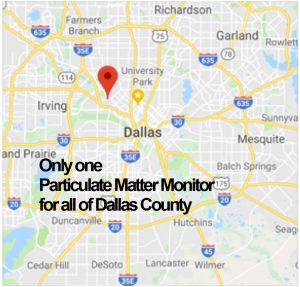
INTO THIS:

Dallas County finalizes documents for founding a regional air quality monitoring network among local governments – will your city, county, school or hospital district vote to join?
In the same week that Downwinders at Risk and the Dallas Sierra Club raised enough money to buy a full-time stationary Particulate Matter monitor for the distressed Joppa community, Dallas County Commissioner Theresa Daniel announced she was sending out documents vetted by the Dallas County District Attorney’s office for the founding of a region-wide air monitoring network to be administered by local governments.
With a working title of “The North Texas Clean Air Network,” the documents propose an Inter-Local Agreement between area municipalities, counties, school and hospital districts to oversee a system of inter-connected particulate matter monitors that insures scientific credibility, uniformity, transparency, and accountability through administration of an appointed board of member representatives.
 This kind of air monitoring network is vastly superior in terms of time and space to what exists now. Instead of only a few monitors for seven million DFW residents spread out over an area the size of a New England state, it would contain hundreds of locations – none further than a block or two away from where ever you are. And instead of waiting for a reading of what the air was like one or two hours previously, these networks can deliver the information in constantly updating five-second intervals, in real time.
This kind of air monitoring network is vastly superior in terms of time and space to what exists now. Instead of only a few monitors for seven million DFW residents spread out over an area the size of a New England state, it would contain hundreds of locations – none further than a block or two away from where ever you are. And instead of waiting for a reading of what the air was like one or two hours previously, these networks can deliver the information in constantly updating five-second intervals, in real time.
The result is a bonanza of data for public health administrators, school officials and urban planners, as well as a new “smart” tool for residents to use in their everyday lives. Planning a run or a walk? Chart the least polluted path. Trying to minimize air pollution from congestion? Tweak the synchronization of your stoplights until you find the timing that produces the least emissions. Track classroom absentee rates to pollution levels and enforce schools’ no idling zones. High-tech low-cost air quality monitoring is one of the most useful applications of emerging smart cities technology.
Air quality monitoring’s potential is recognized in Dallas’ “smart cities”planning chart, placing it under both “Public Health and Safety” and “Equity and Empowerment.” The recent fight over new batch plants in the Joppa’s community and the part Downwinders’ portable monitors played in it shows air monitoring is a powerful new high tech tool for citizens.
Language in the County’s documents initially includes only Dallas County, City of Dallas and City of Plano since those were the three entities represented when informal discussions began last summer, BUT ALL DFW LOCAL GOVERNMENTS ARE INVITED TO JOIN. Reportedly the documents have already been sent to both Dallas and Plano city halls for consideration and action. In Dallas, it’s expected longtime clean air advocate Council Member Sandy Greyson’s Quality of Life Committee will host a hearing on the proposal in the near future.
Given recent events in Joppa, Council Member Kevin Felder is also presumed to be a part of the effort to get Dallas’ to join.
Dense air monitoring networks are being rolled out in many other American and foreign metropolitan areas. Baltimore has proposed a 500-monitor network, Chicago at least as many. Chattanooga has its first ten being built and installed – by a laboratory at the University of Texas at Dallas.
Even though it’s had decades of air pollution problems, DFW has been slow to catch-up with this trend. The North Texas Clean Air Network would begin to address that lag with a first wave of 24 to 50 donated monitors…from that same UTD lab, where Dr. David Lary, one of the world’s leading authority on environmental sensor technologies, teaches physics.
Dr. Lary’s research was just advanced by a large Department of Defense grant to test small high-tech air monitors under a variety of environmental contaminants for possible deployment in the field. This grant and others is allowing UTD to turn its Physics Department into an air monitoring assembly line benefiting the entire region. That’s why the costs of buying and installing the first wave of DFW air monitors is so cheap.
It’s also a reason the public can trust he information they’re getting from the Network as well. Thanks to researchers at the University of North Texas Health Science Center, we know DFW residents are more likely to believe independent third party data about air quality than information they get from government sources.
The documents created by Dallas County are only the first step. Like everything else concerning environmental protection, this monitoring network is a Do-It-Yourself campaign.
ALL THREE NORTH TEXAS CLEAN AIR NETWORK DOCUMENTS TO SHARE WITH YOUR LOCAL CITY COUNCIL, COUNTY COMMISSIONERS COURT, SCHOOL OR HOSPITAL BOARD:
By-laws [pdf-embedder url=”https://www.downwindersatrisk.org/wp-content/uploads/2018/04/North-Texas-Clean-Air-Network-Bylaws-5-2.pdf” title=”North-Texas-Clean-Air-Network-Bylaws-5 2″]
Articles of Incorporation [pdf-embedder url=”https://www.downwindersatrisk.org/wp-content/uploads/2018/04/Articles-of-Incorporation-for-North-Texas-Clean-Air-Network0D0A-5.pdf” title=”Articles of Incorporation for North Texas Clean Air Network 5″]
Interlocal Agreement [pdf-embedder url=”https://www.downwindersatrisk.org/wp-content/uploads/2018/04/North-Texas-Clean-Air-Interlocal-Agreement-5.pdf” title=”North Texas Clean Air Interlocal Agreement 5″]
AIR MONITORING Q&A
What is the Mission of The North Texas Clean Air Network?
1. Provide the best, most up-to-date factual information about local air quality by supervising the implementation and maintenance of a publicly accessible, secure, and scientifically credible regional air sensor network providing simultaneous real time air quality information from multiple locations within member or contracted jurisdictions via the World Wide Web.
2. Provide fact-based public education resources on local air quality.
3. Support scientific research on local air quality by local colleges, universities, hospitals and schools.
4. Work with regulatory agencies and entities to further local clean air goals.
How much would it cost cities and counties to join the Sensor Network?
Nothing. Joining is free, and even the first 25-50 monitors are being donated by UTD and other researchers. Only small electrical and internet connectivity costs for each monitorwill be incurred.
Who will be on the Network’s Board?
1. Sitting Dallas City Council Member
2. Dallas Office of Environmental Quality representative
3. City of Dallas Public Advocate representative
4. Sitting Dallas Commissioners Court member
5. Parkland Health and Hospital representative
6. Dallas County Public Advocate representative
7. Dallas County Medical Society representative
8. Siting City of Plano Council Member
9. Plano Sustainability & Environmental Education Division representative
10. Plano Public Advocate representative
11. Dallas Independent School District representative
(Your Local Government Representative Here When They Join)
How will expansion and operating costs of the Network be paid for?
For the first year, the initial wave of air monitors isb eing donated. Future monitors and maintenance will be paid for by adoption of Network installation and connection fees, grants donations., and directed funding from local governments.
Who will be the Network’s technical supervisor?
Dr. David Lary, UTD Physics Department.
City Hall’s REAL response to West Dallas “Recycling” Fire? Let the EPA call the TCEQ in Fort Worth
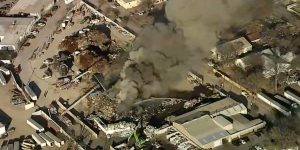
Move along. Nothing to be alarmed about. We asked the manager.
Back on December 11th, there was a serious fire at the “Sunshine Recycling” facility in West Dallas, aka, another West Dallas scrap and junk yard. Beginning at around 3 in the afternoon and continuing to burn overnight, it produced huge clouds of dark thick smoke that covered whole blocks and could be seen for miles on its way toward Irving. There were still “hotspots” requiring attention the morning after, 20 or more hours after ignition.
A Dallas Fire Department spokesperson reported cars, appliances and “other scrap” were burning with intensity.
So if you lived in the neighborhood, you might have been relieved to see your local city council member post on his FaceBook page that “The Fire Dept has conducted testing and there is no hazardous materials burning.”
You might have been reassured to hear the authorities claim, and news media report, that a Dallas Fire Department Hazardous Materials Team was on site.
But none of that was true.
After a lengthy Open Records Act request by Downwinders, many phone calls and emails, we can now piece together what really happened. The Dallas Fire Department never showed up with its Hazardous Mat unit. It never did any air monitoring at the fire. It did no testing.
Instead, at some point that afternoon, as she looked out her window at FountainPlace downtown and saw the fire’s plume wafting only a few miles away, Superfund Division Chief Susan Webster at the Regional EPA office called the Texas Commission of Environmental Quality’s regional office in Fort Worth and asked the state to send someone over to monitor the fire’s smoke. Whether she did this knowing the Dallas Fire Department had already decided not to do any air monitoring itself, or whether is was double-checking is not known. Ms. Webster wouldn’t return our phone calls.
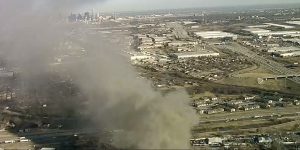
Was seeing this plume from her downtown office building what caused EPA’s Susan Webster to request TCEQ monitoring?
At around 4:30 pm Dallas Fire Department dispatch notes a call from “PCAQ” asking whether the City’s own Haz Mat team was on site and whether any air monitoring was going on. Ted Padgett, a Chief with the DFD, says that “PQAC” was really the “TCEQ” but was misunderstood on the phone.
Told no testing was going on, the TCEQ regional office in Fort Worth begins to assemble a site team and get their own monitoring equipment packed to go – hand held portable monitors.
This is the TCEQ side of that call: “TCEQ staff confirmed, via media coverage and contact with the Dallas Office of Emergency Management (OEM), that a fire was occurring at a scrap metal yard in Dallas. However, staff could not confirm the status of the fire nor what specifically was burning.” Emergency response in the Information Age.
The TCEQ monitoring team shows up in West Dallas at 6 pm – three hours after the fire has started.
Once there, the TCEQ monitoring team has the capabilities to monitor two pollutants: Particulate Matter (PM) and Volatile Organic Chemicals, or VOCs. They took one background sample away from the fire and four samples of about five minutes apiece downwind of the smoke.
The team says it doesn’t find significant VOCs in the air, but of course it’s possible those kinds of highly flammable materials like Benzene (via gas lines and tanks in the burning cars) had already been burned off. The category of VOCs is broad and covers a lot of sins, but it’s not the definitive list of “toxic chemicals” by a long shot. We know burning plastic will produce lots more Dioxins and Furans – the stuff that made Agent Orange so deadly. We know PM pollution can carry lots of bits of metals and other chemicals on them.
We know this because there was a very similar, if slightly more bureaucratic 21-year continuous incineration of car parts, plastics, used oil, dashboards, and scrap at the TXI cement plant in Midlothian, just south of the Tarrant/Dallas County lines. When you look at the before and after volumes of weird laboratory-induced chemical names you can’t really pronounce coming out of the stacks at tests controlled by the company, there’s no question burning junk fills the air full of junk too.
But it you don’t look for it, you won’t find it.
TCEQ was only looking for two kinds of pollutants that night, so it didn’t find anything else. It didn’t even bother to collect PM samples for “chemical characterization” – that is, determine what, if any, toxic baggage like lead or arsenic the PM particles were allowing to hitch a ride on them during the fire. Without such samples, it’s impossible to say the plume was not “toxic” in the “Really-Bad-For-You,” traditional regulatory meaning of that term.
Then there’s what the TCEQ team did find.
TCEQ recorded only four PM samples the whole evening. Half were alarmingly high: 113 ppb near the intersection of Singleton and Westmoreland, over three miles away, and 180 ppb near the intersection of Chalk Hill Road and Singleton between one and two miles from the fire.
Two other samples, one taken way north along Bernal And Hammerly, and further south down Westmoreland at Canyon Bluff showed “background” levels of PM at 14 ppb and 18 ppb respectively.
The EPA annual standard for PM exposure is 12 ppb, the daily standard is 35 ppb. The results from two of the four samples TCEQ took were three and five times the daily standard. That’s “toxic” in the “Science-Says-That-Stuff-Will-Kill-You” way.
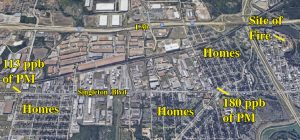
The TCEQ inspectors left after only about an hour. No other monitoring took place for the duration of the fire, which was still going the next morning. So out of approximately 20 hours the incident lasted, only one was monitored.
TCEQ did note that the wind was out of the West at 10 mph and that “Potentially Impacted Receptors” included residences and businesses between Highway 12 and I-30.
There’s no record of the Dallas Fire Department, or anyone at Dallas City Hall, asking for the TCEQ’s monitoring results and TCEQ never sent them to anyone there. It wasn’t until Downwinders requested the results through an Open Records Request that any member of the public had seen the full record of what was done.
But some West Dallas residents complained about health effects from the fire to State Senator Royce West. One email the Senator got related how the fire had caused “my throat to become scratchy, coughing …. The smoke was so thick it hovered over all of West Dallas. The smell was horrific, very strong & lingering. You could smell it from loop 12 & all over West Dallas & I’m sure the lingering included other local surrounding areas in our city. The fire department said by it being cold outside, it causes the materials burning & the smoke in the air to continue to stay low where it affects us when breathing.“
Senator West’s office wrote a letter to the TCEQ regional office asking about what they’d found when they did their air monitoring. Here’s the reply he got:
“Smoke is a complex mixture of gases and fine particles. While the main pollutant of concern in smoke is the particulate matter, smoke may also contain other pollutants that are dependent on the product that is burnt, the moisture content of the product, and the fire temperature. Particles from smoke are often very small in size and have diameters that are 2.5 micrometers and smaller (PM 2.5). These particles are respiratory and eye irritants. Short-term exposures (hours-weeks) to these particles can cause headaches, respiratory (e.g., runny nose, scratchy throat, irritated sinuses, and bronchitis) and eye irritation (e.g., burning eyes). However, these symptoms typically disappear quickly once the person gets out of the smoke. Exposures to high concentrations of these particles can cause persistent cough, phlegm, wheezing, and difficulty breathing. While some people are more susceptible to the adverse health effects of smoke, particles from smoke can also cause respiratory symptoms, transient reductions in lung function and pulmonary inflammation in healthy adults. Children, older adults, and people with pre-existing heart or lung disease are more susceptible to lower levels of smoke than healthy people…(monitored) PM ranged from 0-180 ppb…..”
No mention of the scientific consensus that even short term exposure to low levels of PM can cause a host of permanent heath injuries, including brain and learning disorders, immune damage, and life-long respiratory ailments. No mention that fully half the samples taken by TCEQ were over 100 ppb and exceeded the 24-hour EPA standard for that specific pollutant. In fact, TCEQ says, all of your problems should disappear once you get out of the smoke – or your house, if the smoke from the toxic fire down the street is making it unlivable.
There’s an email from a TCEQ Special Assistant to the Deputy Director in Austin that asks: “…is there any way to put the highlighted PM detection in context….is this the level we would normally expect to find in smoke; at what level would we take action, can hand-held equipment quantify, etc?
She didn’t get a reply to those questions that we saw. Probably because no one at the Austin or Fort Worth TCEQ offices really knew the answers, or didn’t want to write them down and send them to a State Senator.
TCEQ was able to tell the Senator West that, despite plastics and metals and other materials on-site capable of producing toxic smoke, there were “no hazardous chemicals” on-site or involved in the fire.
How did it know? TCEQ inspectors asked the manager of the facility. There was no independent inspection.
And that, Dear Citizens, is how you’re protected by potentially toxic fires in Dallas, Texas. Feel safer?
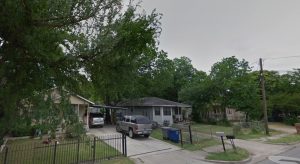
Homes along Singleton probably exposed to some of the worst fallout of the December 11th fire.
Along with the high PM levels our PM Committee found in Joppa, this incident is another case study of why Dallas should have its own 24/7/365 dense network of air quality monitors – monitors that will be there when such a fire starts, as well as when it’s finally extinguished. Monitors who won’t make the value judgement about when the A Team should be called out. Because along with all the other questions this response poses you have to ask yourself if something like this happened in Preston Hollow or Uptown, would the Dallas Fire Department have still shown-up without its hazardous materials crew in tow?
This incident is Exhibit A why Dallas should also be incorporating public health into emergency responses. Why doesn’t the Fire Department have access to its own toxicologist or public health expert who could tell them what to sample for, where to sample, and whether the fire really posed any concern to neighbors or not? Why isn’t the automatic response to a fire like this to send out its own hazardous materials team instead of outsourcing it to TCEQ, 30 minutes away in Fort Worth?
December 11th allows us to peak behind the the modern post 9/11 facades of “Public Safety” and “Emergency Response” we all take for granted and see what a decrepit cynical reality is in charge of assuring us that “there’s no reason to be concerned.” That’s why we need a new reality.


